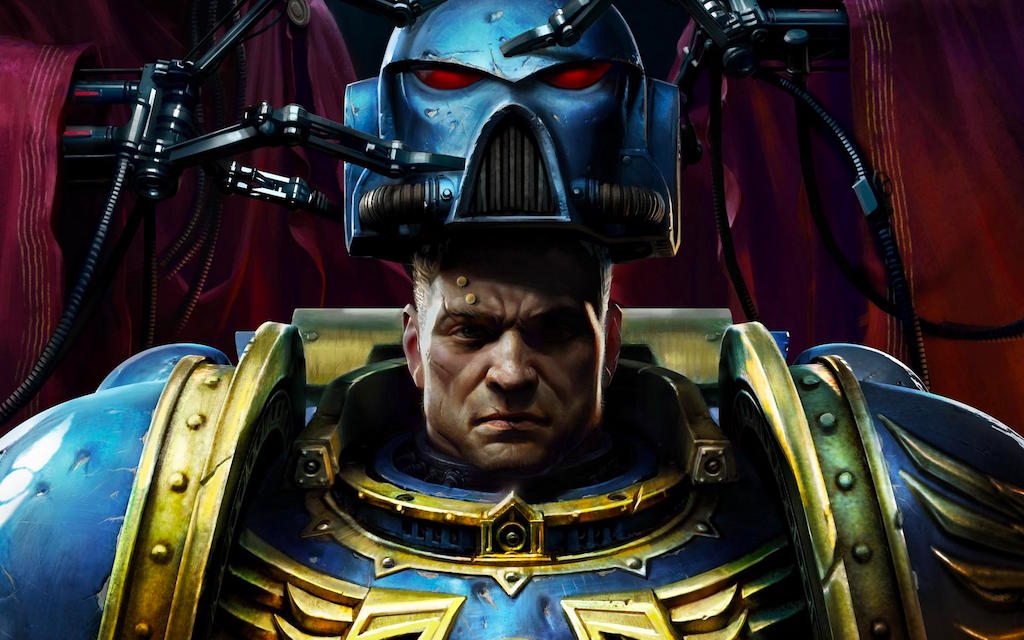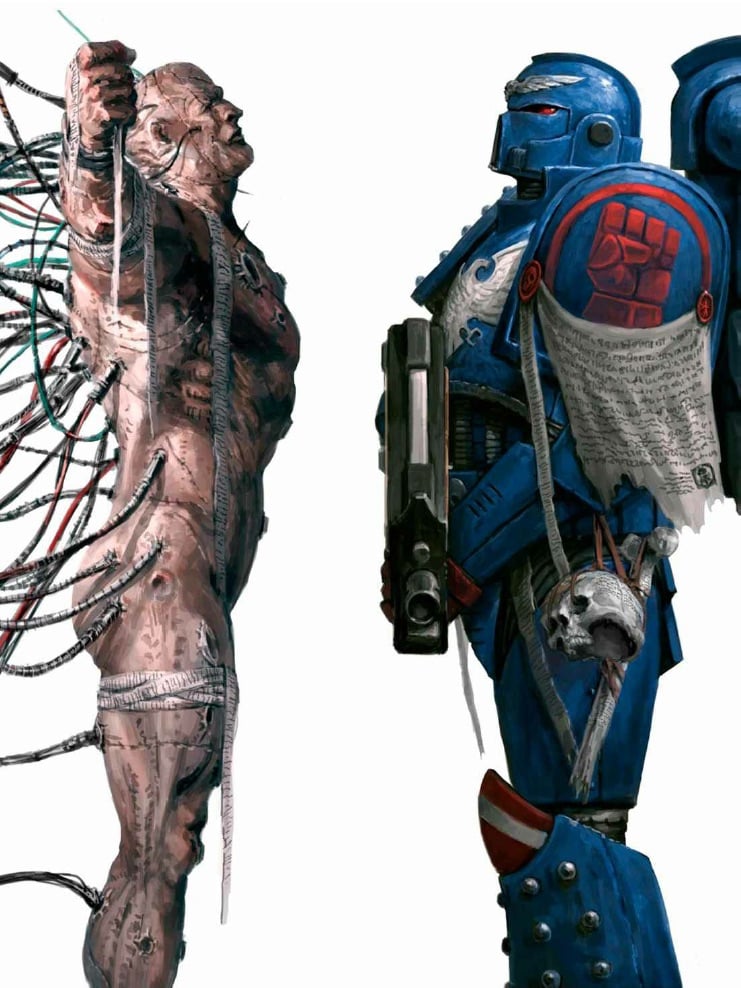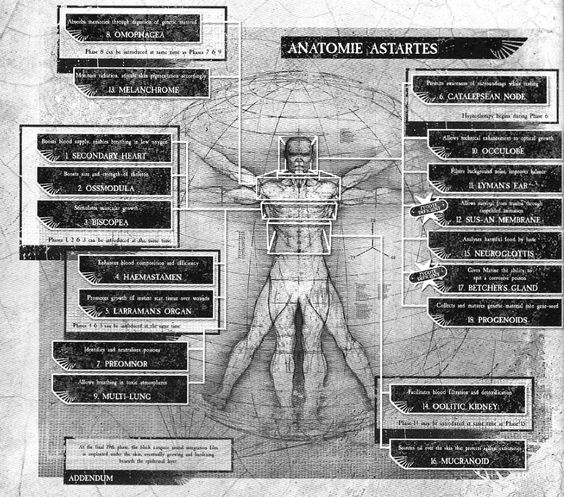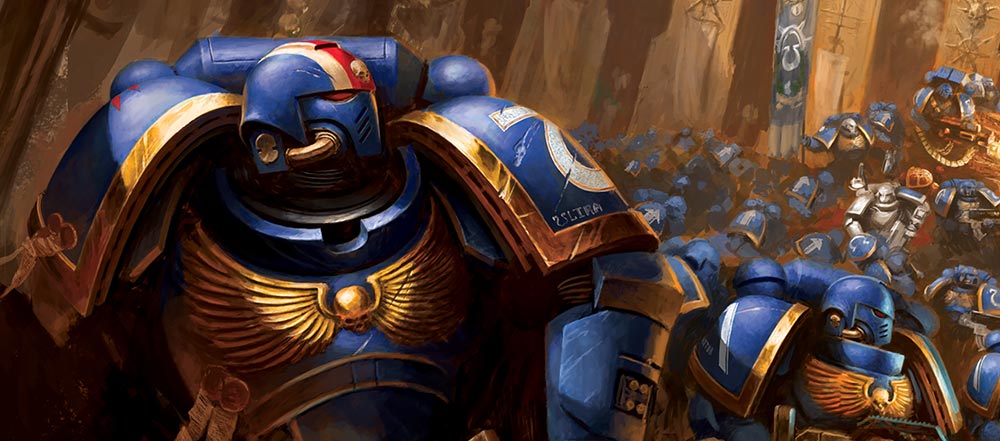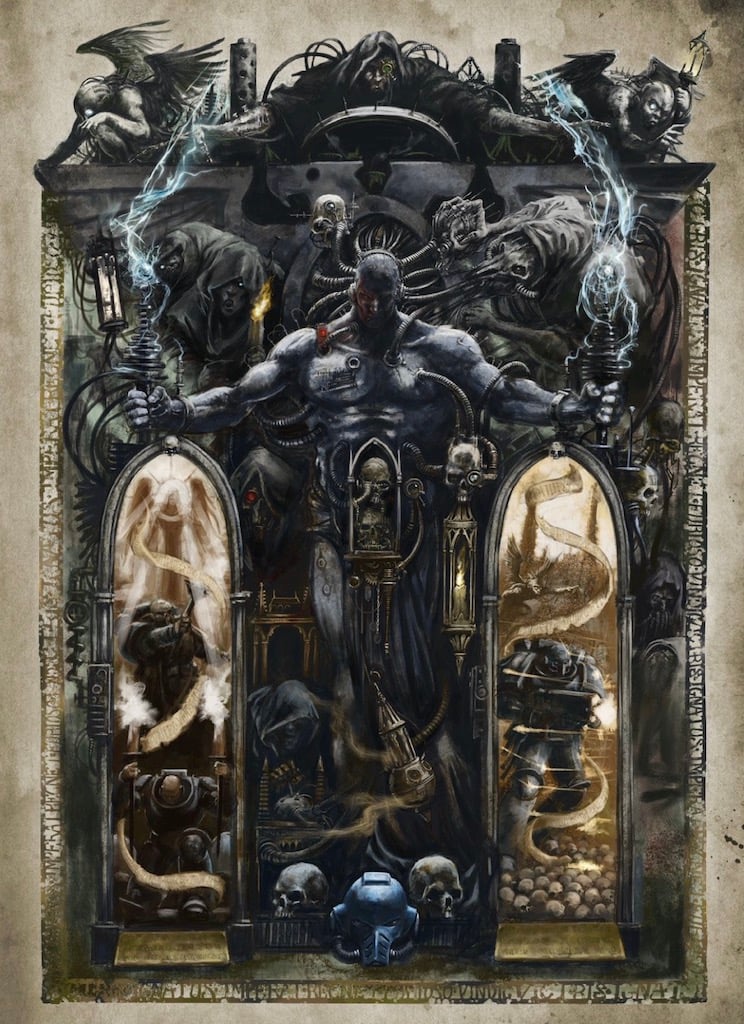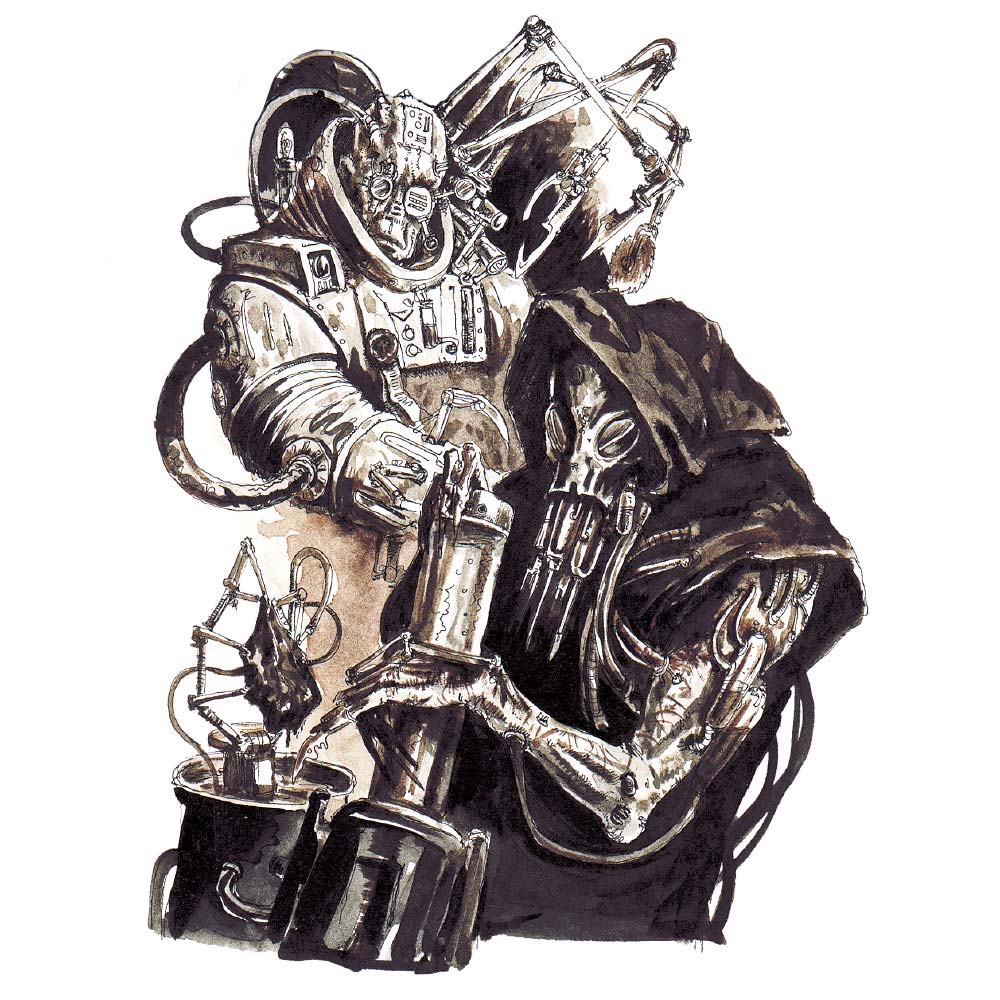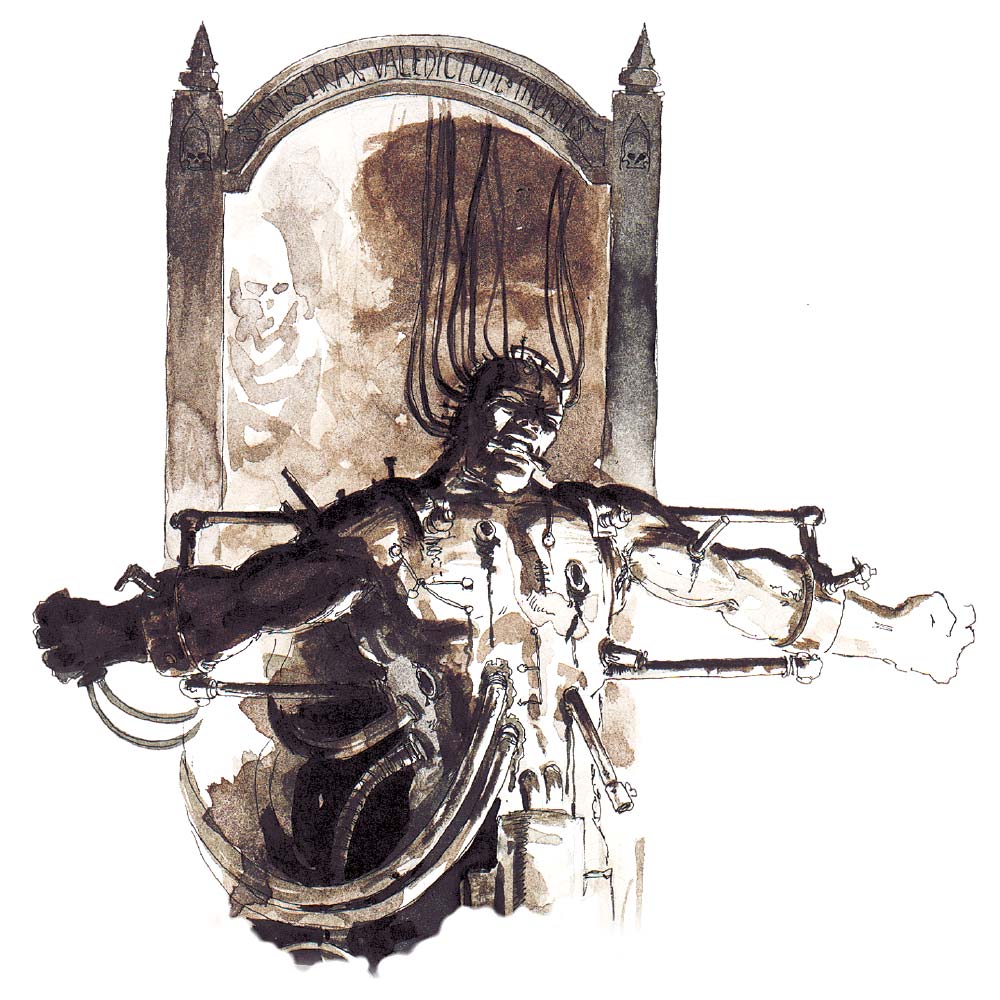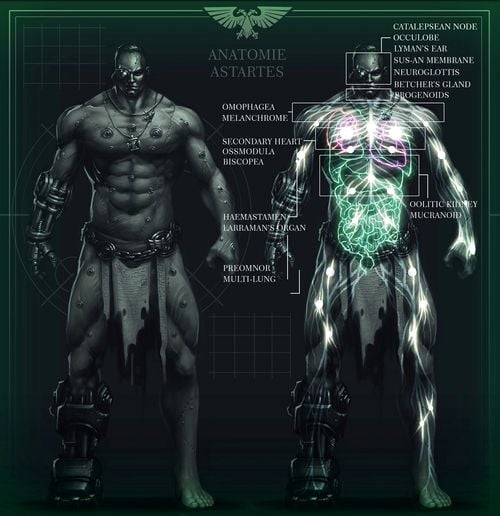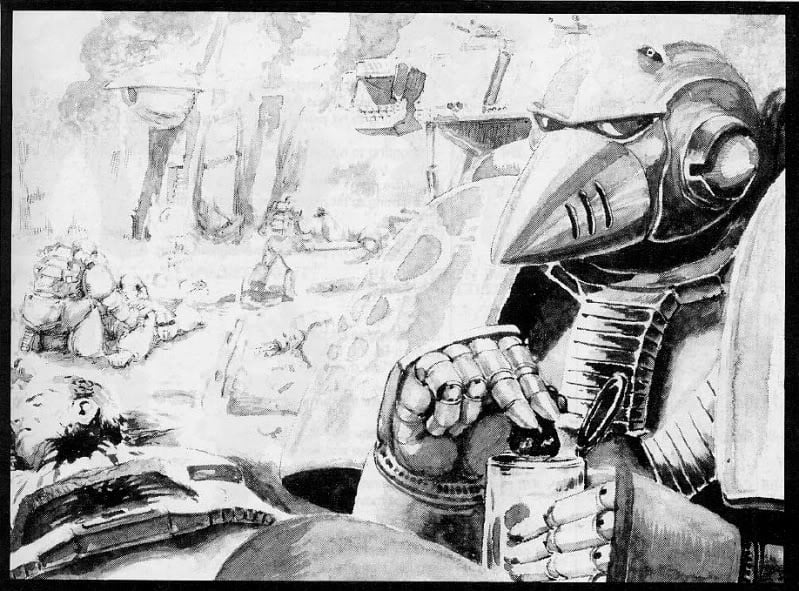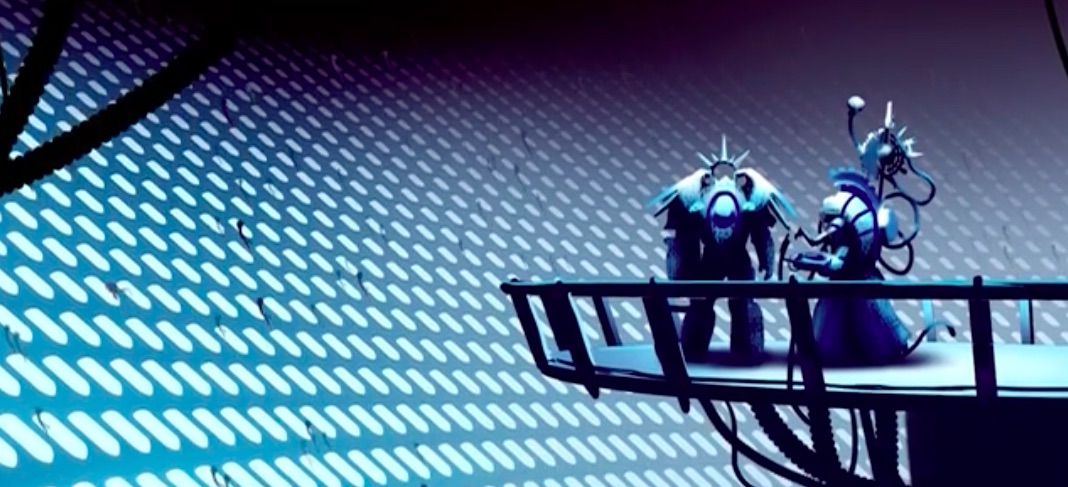Warhammer 40K: Creation of a Space Marine
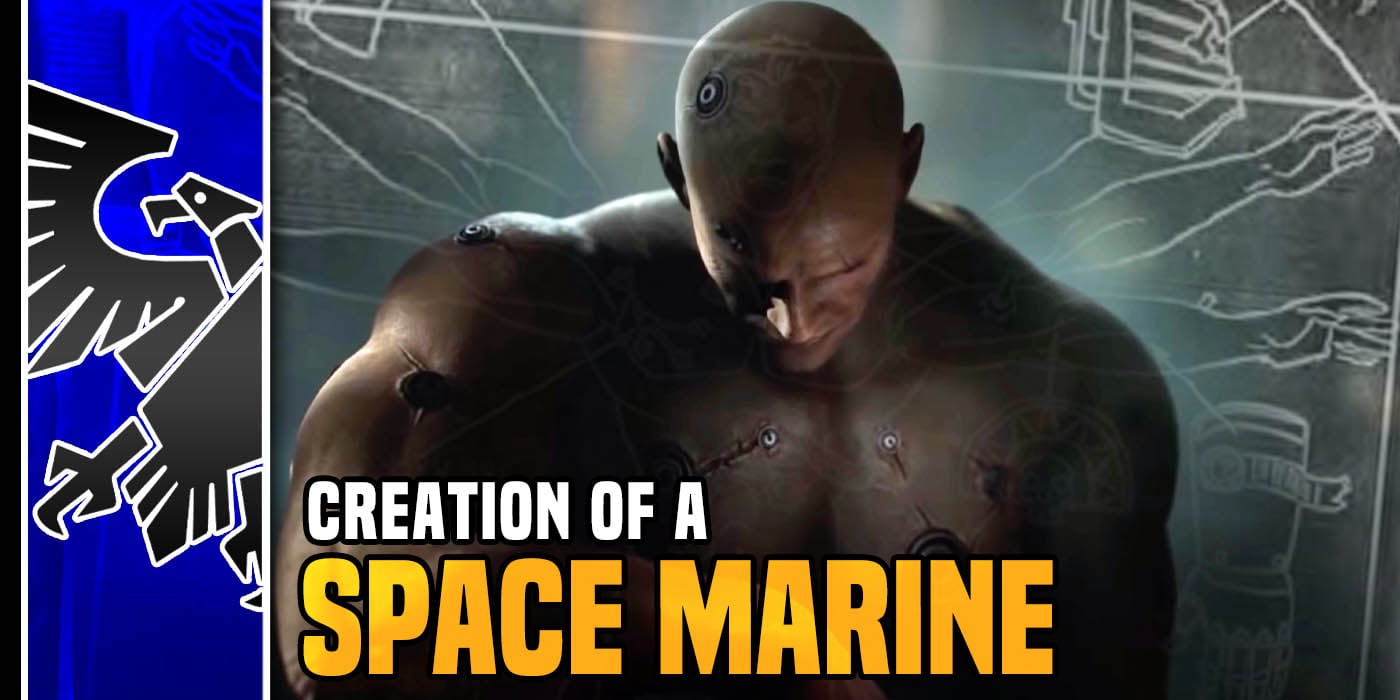
Come fellow Apothacaries and learn how the Imperium shapes the clay of humanity into the Angels of Death – the Space Marines
To Build a Space Marine
It takes a considerable deal of time to transform a normal human into a Space Marine. They receive implants known as gene-seed which transform their bodies and give them superhuman abilities – making them capable of spitting acidic venom, absorbing the memories of the dead by eating their flesh, darkening their skin to protect it from radiation, and operating for long periods without sleep by switching off parts of their brains at a time.
Selection
Recruits are chosen from the best warriors among humanity. Naturally, this makes Death and Feral Worlds prized recruitment grounds, as such harsh and primal conditions produce the best warriors. However, hive worlds are considered the ideal source of potential recruits, the populace of the lower levels composed of some of the most murderous scum in the human Imperium. Whole gangs of hive scum are sometimes hunted down and captured for recruitment. Among the most valued traits in a recruit are aggression and psychotic-level killer instinct. More rarely, certain Civilized Worlds are also recruited from.
Requirements
Recruits must be fairly young, because implants often do not become fully functional if the recipient has reached a certain level of physical maturity. They must be male because the zygotes are keyed to male hormones and tissue types. Only a small percentage of people are compatible to receive the implants and hypno-suggestion to turn them into Marines. Before the process of implantation begins the potential recruit receives tissue compatibility tests and psychological screening. If the testing proves successful the recruit becomes a neophyte. After the organ implantation process, he becomes an initiate.
Even once the organs are implanted they are generally inactive or useless without associated training and hypnotherapy and chemical treatment. Most recruits join the ranks as a brother between the age of 16-18 years.
Astartes Implants
The 19 implanted organs are very complicated. Because several of them only work properly or at all in the presence of other implants, the removal, mutation or failure of one organ can affect the precise functioning of the others. Because of this, and the fact that each Chapter’s gene-seed belongs to that Chapter alone. Different Chapters display different characteristics and use different sets of implants and methods of implantation.
Throughout the implantation process, the Marine must undergo various forms of conditioning in order for the implanted organs to develop and become part of his physiology.
Listed below is the complete set of implants used:
- Phases 1-3 can be introduced at the same time, ideally between 10 and 14 years of age.
- Phases 4 and 5 can be introduced at the same time, ideally between 12 and 14 years of age.
- Hypnotherapy normally begins at phase 6, ideally sometime between 14 and 17 years of age.
- Phases 7 to 9 are normally introduced simultaneously, ideally at a point between 14 and 16 years old. The following series of organs are also ideally implanted between the ages of 14 and 16.
- Phases 14 and 15 may be introduced at the same time, ideally between 15 and 16 years of age. The remaining series of implants are then ideally introduced to the recipient between the ages of 16 and 18.
Secondary Heart
Phase 1: This simplest and most self-sufficient of implants allows a Space Marine to survive his other heart being damaged or destroyed, and to survive in low oxygen environments. Not just a back-up, the secondary heart can boost the blood-flow around the Marine’s body.
Ossmodula
Phase 2: A small, complex, tubular organ, the ossmodula secretes hormones that both affect the ossification of the skeleton and encourages the forming bone growths to absorb ceramic-based chemicals that are laced into the Marine’s diet. This drastically alters the way a Space Marine’s bones grow and develop. Two years after this implant is first put in the subject’s long bones will have increased in size and strength (along with most other bones). The rib cage will have been fused into a solid mass of bulletproof, interlocking plates.
Biscopea
Phase 3: This small, circular organ is inserted into the chest cavity and releases hormones that vastly increase muscle growth throughout the marine’s body. It also serves to form the hormonal basis for many of the later implants.
Primaris Implants
In addition to the above, the new line of Primaris Space Marines are given three additional implants that allow for their superior size and strength in addition to a greater level of genetic stability. The Primaris Implants take place between Phases 3 and 4, known as the Primaris Alpha and Primaris Beta phases. Both phases can be introduced simultaneously.
Sinew Coils
Known as the Steel Within, the Space Marne’s sinews are reinforced with durametallic coil-cables that contract with incredible force, magnifying the subjects strength beyond that of a regular Space Marine and giving another layer of interior defense.
Magnificat
Known as the Amplifier, this small thumbnail-sized lobe is inserted into the brain’s core. The implant secretes hormones that increases the body’s growth functions while also intensifying its advanced systems, especially for the ossmodula and biscopea. In truth, this implant is but half of the true, dual-valve immmortis gland (the “God-Maker”) which the Emperor made for the Primarchs. Belisarius Cawl was able to build the dextrophic lobe (right half) but discovered that information on the sintarius (left half) had been wholly eradicated by an unknown force.
Belisarian Furnace
Known as the Revitalizer, this dormant organ connects to both hearts. In times of extreme stress or trauma, it expels self-manufactured chemicals similar to combat stimms that also aids in regeneration. After activation the gland will fall dormant again, taking some time to build up itself for activation once more.
Haemastamen
Phase 4: Implanted into the main circulatory system, this tiny implant not only increases the hemoglobin content of the subject’s blood. This makes it more efficient at carrying oxygen around the body and makes the subject’s blood a bright red. It also serves to monitor and control the actions of the phase 2 and phase 3 implants.
Larraman’s Organ
Phase 5: A liver-shaped organ about the size of a golf-ball, this implant is placed within the chest cavity and connected to the circulatory system. It generates and controls ‘Larraman cells’ which are released into the bloodstream if the recipient is wounded. They attach themselves to leucocytes in the blood and are carried to the site of the wound. Whereupon contact with air they form a near-instant patch of scar tissue, sealing any wounds the Space Marine may suffer.
Catalepsean Node
Phase 6: Implanted into the back of the brain, this pea-sized organ influences the circadian rhythms of sleep and the body’s response to sleep deprivation. If deprived of sleep, the catalepsean node cuts in. The node allows a Marine to sleep and remain awake at the same time by switching off areas of his brain sequentially. This process cannot replace sleep entirely. But increases the Marines’s survivability by allowing perception of the environment while resting. This means that a Space Marine needs no more than 4 hours of sleep a day, and can potentially go for 2 weeks without any sleep at all.
Preomnor
Phase 7: This is essentially a pre-stomach that can neutralize otherwise poisonous or indigestible foods. No actual digestion takes place in the preomnor, as it acts as a decontamination chamber. It is placed before the natural stomach in the body’s system and can be isolated from the rest of the digestive tract in order to contain particularly troublesome intake.
Omophagea
Phase 8: This implant, also called “the Remembrancer”, allows a Space Marine to ‘learn by eating’. It is situated in the spinal cord but is actually part of the brain. Four nerve bundles are implanted connecting the spine and the stomach wall. Able to ‘read’ or absorb genetic material consumed by the marine, the omophagea transmits the gained information to the Marine’s brain as a set of memories or experiences. It is the presence of this organ that has led to the various flesh-eating and blood-drinking rituals for which the Astartes are famous, as well as giving names to chapters such as the Blood Drinkers and Flesh Tearers. Over time, mutations in this implant have given some chapters unnatural cravings for blood or flesh.
Multi-lung
Phase 9: This additional lung activates when a Space Marine needs to breathe in low-oxygen or poisoned atmospheres, and even water. The natural lungs are closed off by a sphincter muscle associated with the multi-lung and the implanted organ takes over breathing operations. It has highly efficient toxin dispersal systems.
Occulobe
Phase 10: This implant sits at the base of the brain, and provides hormonal and genetic stimuli which enable a Marine’s eyes to respond to optic-therapy. This in turn allows the Apothecaries to make adjustments to the growth patterns of the eye and the light-receptive retinal cells – the result being that Space Marines have far superior vision to normal humans, and can see in low-light conditions almost as well as in daylight.
Lyman’s Ear
Phase 11: Not only does this implant make a Space Marine immune from dizziness or motion sickness but also allows Space Marines to consciously filter out and enhance certain sounds. The Lyman’s Ear completely replaces a Marine’s original ear. It is externally indistinguishable from a normal human ear.
Sus-an Membrane
Phase 12: Initially implanted above the brain, this membrane eventually merges with the recipient’s entire brain. Ineffective without follow-up chemical therapy and training. With sufficient training a Space Marine can use this implant to enter a state of suspended animation, consciously or as an automatic reaction to extreme trauma. This will keep the Marine alive for years, even if he has suffered otherwise mortal wounds. Only the appropriate chemical therapy or auto-suggestion can revive a Marine from this state. The longest recorded period spent in suspended animation was undertaken by Brother Silas Err of the Dark Angels, who was revived after 567 years.
Melanchromic Organ
Phase 13: This implant controls the amount of melanin in a Marine’s skin. Exposure to high levels of sunlight will result in the Marine’s skin darkening to compensate. It also protects the Marine from other forms of radiation.
Oolitic Kidney
Phase 14: In conjunction with the secondary heart this implant allows a Space Marine to filter his blood very quickly, rendering him immune to most poisons. This action comes at a price, however, as this emergency detoxification usually renders the Marine unconscious while his blood is circulated at high speed. The organ’s everyday function is to monitor the entire circulatory system and allow other organs to function effectively.
Neuroglottis
Phase 15: This enhances a Space Marine’s sense of taste to such a high degree that he can identify many common chemicals by taste alone. A Marine can even track down his target by taste.
Mucranoid
Phase 16: This implant allows a Space Marine to sweat a substance that coats the skin and offers resistance to extreme heat and cold and can even provide some protection for the marine in a vacuum. This can only be activated by outside treatment, and is common when Space Marines are expected to be fighting in vacuum.
Betcher’s Gland
Phase 17: Consists of two identical glands, implanted either into the lower lip, alongside the salivary glands or into the hard palette. The gland works in a similar way to the poison gland of venomous reptiles by synthesizing and storing deadly poison, which the Marines themselves are immune to due to the gland’s presence. This allows a Space Marine to spit a blinding contact poison. The poison is also corrosive and can even burn away strong metals given sufficient time.
Progenoids
Phase 18: There are two of these glands, one situated in the neck and the other within the chest cavity. These glands are vitally important and represent the future of the Chapter. The only way new gene-seed can be produced is by reproducing it within the bodies of the Marines themselves. This is the implant’s only purpose. The glands absorb genetic material from the other implanted organs. When they have matured each gland will have developed a single gene-seed corresponding to each of the zygotes which have been implanted into the Marine.
These take time (5 years in the first case, 10 in the latter) to mature into gene-seed. The gene-seed can then be extracted and used to create more Space Marines.
The Phase 19 Black Carapace interfaces can be seen on this mature Marine
Black Carapace
Phase 19: The most distinctive implant. It resembles a film of black plastic that is implanted directly beneath the skin of the Marine’s torso in sheets. It hardens on the outside and sends invasive neural bundles into the Marine’s body. After the organ has matured the recipient is then fitted with neural sensors and interface points cut into the carapace’s surface. This allows a Space Marine to interface directly with his Power Armour. Without the Black Carapace many of the systems of the power armour will not function. While driving the vehicles of the Chapter, special spinal interface plugged into power armour and Black Carapace to provide the Space Marine an intuitive ‘feel’ for vehicles systems and controls, literally making him a part of his vehicle.
That’s just the physical organs – now onto the training and indoctrination…
Learn More of Space Marine Creation
~ We will see if the experiments of Fabius Bile can match Cawl’s greatest work.

